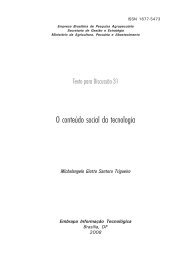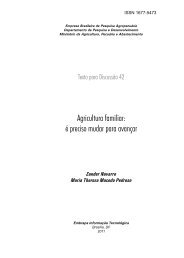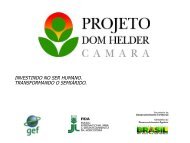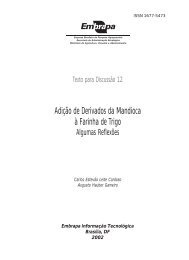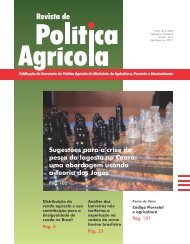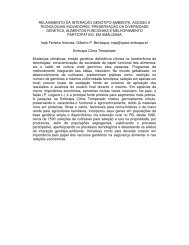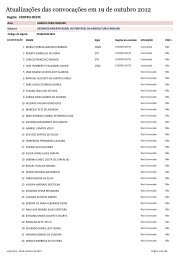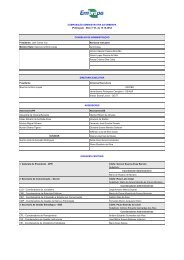Ministry of Agriculture, Livestock and Food Supply - Embrapa
Ministry of Agriculture, Livestock and Food Supply - Embrapa
Ministry of Agriculture, Livestock and Food Supply - Embrapa
You also want an ePaper? Increase the reach of your titles
YUMPU automatically turns print PDFs into web optimized ePapers that Google loves.
Adding fuel alcohol to the cogeneration <strong>of</strong> electric power from bagasse,<br />
sugarcane is today the largest renewable source <strong>of</strong> energy in Brazil. According<br />
to the National Energy Balance, the biomass share in the Brazilian energy<br />
matrix in 2003 was 27%; <strong>of</strong> which sugarcane bagasse accounted for 12.6%;<br />
firewood <strong>and</strong> charcoal, for 11.9%; <strong>and</strong> other sources, for 2.5%.<br />
Sugarcane plantations in Brazil spread over almost 6-million hectares,<br />
<strong>of</strong> which 85% are located in the Center-South, particularly in the State <strong>of</strong> São<br />
Paulo (60%), <strong>and</strong> the remaining 15%, in the North <strong>and</strong> Northeast Regions.<br />
Approximately 380-million tons were milled in the 2004 harvest, <strong>and</strong><br />
about 48% <strong>of</strong> them were used for alcohol production. The bagasse from the<br />
crushing operation was burned in the mills' boilers, which made the mills<br />
self-sufficient in energy. In many cases the mills have energy surpluses, which<br />
can be sold. Total alcohol production was 15.2-billion liters <strong>and</strong> the total power<br />
generated was more than 4GWh during the harvest, or approximately 3% <strong>of</strong><br />
the country's annual power generation capability.<br />
Despite the huge cogeneration potential resulting from the increased<br />
energy efficiency <strong>of</strong> the sugar mills, the generation <strong>of</strong> electric power is only<br />
one <strong>of</strong> the uses <strong>of</strong> bagasse. There is ongoing research focusing on the<br />
transformation <strong>of</strong> bagasse into alcohol using lignocellulose hydrolysis, as well<br />
as into biodiesel; or even making better use <strong>of</strong> bagasse in the furniture industry<br />
<strong>and</strong> in the production <strong>of</strong> feeds.<br />
Brazilian experience with fuel alcohol<br />
At the end <strong>of</strong> 1979 only anhydrous alcohol was being used as fuel 7 .<br />
In addition to being extremely dependent on imported petroleum, most<br />
Brazilian exports were agricultural commodities at the time, which would<br />
prevent the country from achieving equilibrium in the balance <strong>of</strong> trade if the<br />
growth trend <strong>of</strong> petroleum imports were maintained. The second petroleum<br />
shock led the government <strong>and</strong> the automobile industry to establish a<br />
partnership to push the technological development <strong>of</strong> vehicles fueled<br />
exclusively with alcohol. In 1980 the federal government determined that<br />
alcohol would be sold to consumers for 60% the price <strong>of</strong> gasoline, which<br />
established an advantageous parity in the price to caloric power ratio.<br />
7 The first experiences with ethanol in Otto Cycle engines date back to the beginning <strong>of</strong> the 20th<br />
century. In 1912 some vehicles were fuel driven in an experiment. In 1931 the Brazilian government<br />
authorized the use <strong>of</strong> 2-5% alcohol mixed in gasoline. The alcohol content was increased to 5-10%<br />
in 1961.<br />
67



